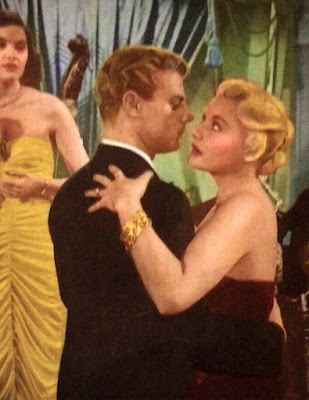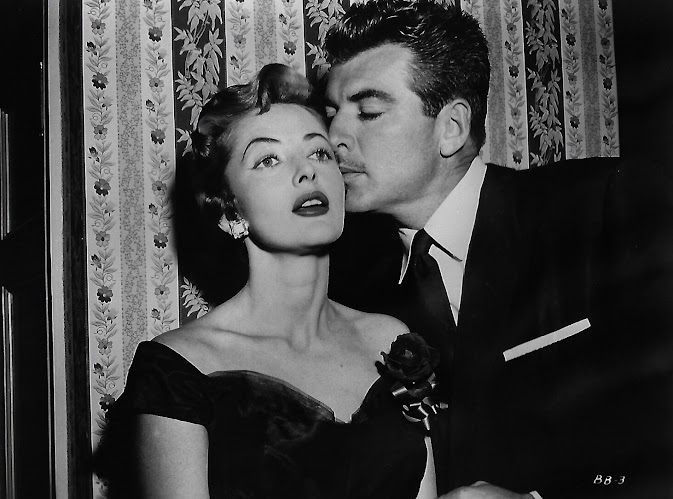Film Noir #25
Noir: Appointment With a Shadow, The Assassin, Bad Blonde, and The Big Bluff
Still struggling to get out of A and B titles, quicksand too thick to loose me forward in Noir's murky alphabet. Would I have started this project knowing there would be so many?
APPOINTMENT WITH A SHADOW (1957) --- Recent-issued 72 minutes in black-and-white scope from Universal-International, not seen properly for many years until Kino took a flyer on Blu-Ray release for a latest Noir box, proof again how something buried can be happily exhumed to show what we’ve missed for way too long. Appointment With a Shadow is no rediscovered classic, but for those who enjoy 50’s U-I and all its works (me!), there is much to appreciate and enjoy. Did this cost even $100K to finish? --- because from look of things, a Playhouse 90 might have took more to get on the air, but audiences by now used to cramped environs of TV drama kept Appointment on terms of second feature with whatever was expected to excite more. George Nader is an alcoholic reporter getting his chance at redemption via witnessing a murder not the murder police think they’ve solved, Nader knowing the victim is a plant and that the killer remains at large. I checked to see if this yarn had paperback origins or was found in Cornell Woolrich’s overcoat pocket, but no, it was handiwork of three Universal staffers who did shared best within limit of time they undoubtedly had. Effective first third has Nader white knuckling a long day without drink to keep his date with destiny, and from there comes chase and being chased by bad man Frank deKova. I cheer-led for Nader throughout, his character close to real-life eight balled near-star who’d be sacrificed to wolves bred by 50’s era scandal mongering, a story told other places, and possibly to go into when time comes to talk of Man Afraid, another Nader U-I from good offices of Kino. Rousing cheer to that distributor for giving us so much Uni treasure, and long may they continue doing so.
THE ASSASSIN --- aka The Venetian Bird (1952) --- Search is on for a war hero who’s maybe a heel plus potential killer, Richard Todd the Brit private eye in Naples to sort mystery out. Again as with Euro-set noirs The Third Man is evoked, past deeds and misdeeds dredged toward normalizing postwar lives. Sleuths in habit of asking irksome questions saw targets painted on back by continentals with much to hide, motivations murkier than what drove whodunits past. Todd begins cheerful, nattily turned out, his a seeming Cook’s tour of canals and perhaps romance for chaser, but suspects here are all suspicious, being allied toward liquidation of a visiting dignitary, Todd well over his head in attempt to stop it. Location is a help and nothing looks set-built, The Venetian Bird (I prefer calling it that) reminiscent also of in-fashion filmmakers who shunned phony backdrops, many of these operating in Italy (did some assist on The Venetian Bird?). Here is as much inspiration to book a next vacation as to solve the riddle and clear killings, Venice a lovely spot whatever depredations done by villainy. Another of efforts by the Rank Organization to crack worldwide markets, The Venetian Bird flew US ways in 1953 under blunter title of The Assassin, meaning of which doesn’t come clear until final third of the story, but how else to scratch exploitation itch of audiences to whom The Venetian Bird would seem too obscure a label? An interesting book could come of efforts to sell Brit product in a domestic market, let alone foreign language output even tougher to earn acceptance from Yanks. In fact, there has been coverage, of academic bent it's true, but with solid info and sad realization that too few imports saw success on American soil. The Venetian Bird is part of a Kino “British Noir” DVD collection. Quality is fine.
BAD BLONDE (1952) --- Barbara Payton judged as having little left to offer in American films was something else entirely for Brit watchers to whom she was uninhibited alternative to home based players observing rules of decorum. Did Bad Blonde make a UK splash not felt on US shores? Payton in tawdry headlines expelled her from major makers at home, so Robert Lippert sent a now soiled dove across for two, Bad Blonde and Four-Sided Triangle, latter a first sci-fi from Hammer, doing then-business as Exclusive Films. Her as spent US novelty might be novel anew for England. Who were sex lures for Britain filmgoers prior to 1952, let alone a specifically blonde sex lure? Diana Dors reinvented herself thus for same year’s Man Bait, and that would transform a former jobbing actress doing variety of parts large and small to a most-of-time vamp. Did Dors wish she could stay a utility player rather than caricature that success obliged her to become? “The first and only British blonde bombshell” was how Dors described herself … interesting that a same season saw she and Barbara Payton chasing similar carrot. Difference was Payton’s career and circumstance being less stable, in fact far more chaotic. She would not again have opportunity as Bad Blonde afforded, in England or Hollywood. Capable Brits support her, but Payton was what lent star quality to Bad Blonde, being flamboyant where colleagues were subdued. Were Yanks encouraged to give it the gas when guesting in UK features? That had to be a principal reason they were sent over, to lend H’wood dynamism to what was thought dour product otherwise. Barbara Payton makes the case for her brief prominence in Bad Blonde. Too bad she couldn’t sustain it longer, overseas, or back home. VCI has Bad Blonde in a Hammer Noir box set.
THE BIG BLUFF (1955) --- An ultra-cheapie to make AIP at the time look lavish, The Big Bluff directed by H. Lee Wilder, Billy’s brother oft-disparaged by the more famed sibling who I assume struck Lee from his Christmas card list well before either made US landfall. What was so distasteful about hapless Lee? As a director, he couldn’t punch ways out of a wet bag, yet “signed” his on-screen credit like Mitchell Leisen, and Billy didn’t like Mitch either. Let’s face it … some folks simply rub us wrong ways and often that’s more our problem than theirs. Was humble helmsman of The Snow Creature and Killers from Space really a “dull son of a b---h”? Billy thought so, often said so. Not sure I would have enjoyed being latter’s writing partner, whatever Oscars and renumeration might have come my way. Enough of personalities however – what about The Big Bluff? United Artists distributed, or rather let it loose … what I saw on You Tube looked like TV shot on dreary days, and yet there are points of interest. Always engaging is theme of a gigolo in pursuit of rich widows, in this case John Bromfield after wilting quarry that is Martha Vickers. She’s doing Dark Victory dance and John hasn’t much time to seal the deal, ironies laid in wait provided we last seventy-one minutes. Robert Hutton is along as treating physician. Did he and Martha ruminate upon past days when both were briefly floated as potential stars at Warners? The cast moves about cramped sets like inside of shipping crates … makes one want to step outdoors to breathe open air. Writers have said the fifties spelled an end to B pictures. The heck it did. There were more of them that decade than I or anyone can calculate, thanks to drive-ins and continued proliferation of double bills answering need of more, and still more, product. There are numerous PD iterations on The Big Bluff, so see it on You Tube or pick poison disc-wise.








4 Comments:
Hi, John -- Bravo for your observation:
Writers have said the fifties spelled an end to B pictures. The heck it did. There were more of them that decade than I or anyone can calculate, thanks to drive-ins and continued proliferation of double bills answering need of more, and still more, product.
I remember reading an open letter from a 1950s exhibitor bemoaning the trouble he had booking B features. He had been renting Columbia and Monogram Bs for $7.50 each, and was now regretting how the pickings were leaner and more expensive. It should be remembered that in the fifties, admissions were paid in coins -- generally between 50 and 75 cents -- so exhibitors had to watch every penny to cover their overhead.
Many studios kept their older pictures in reissue to meet the demand for inexpensive product -- Columbia still had its serials and Charles Starrett westerns playing into the 1960s, same with Universal's Ma and Pa Kettle features, same with Paramount's Martin & Lewis pictures.
What ended -- in a way -- were the major studio programmers. Their assembly lines were retooled to feed the small screen, with B personnel turning out the usual B material on shorter budgets and schedules. What theatrical B product they did produce was less plentiful, largely indistinguishable from their TV product, and too expensive for Mr. McGillivray's unhappy exhibitor.
This created a huge opening for AIP and other upstarts. They stepped into the breach with more affordable product and lots of it. More importantly, they saw who was buying tickets and catered to them in a way the majors and television couldn't or wouldn't. Disney sold "The Monkey's Uncle" to the whole family, careful to not offend Granny or confuse Junior. AIP sold "Beach Blanket Bingo" to just the teens, not needing Granny or Junior for box office success (If you think BBB now plays as prudish, compare to the uptight Disney effort).
There also came a moment when non-artsy foreign films cracked the American market in a big way. Hammer horrors from England, musclemen and gritty cowboys from Italy, anime from Japan, and proto-softcore from everywhere. Could these be counted as Bs?
Dan Mercer has some thoughts concerning BAD BLONDE:
“Bad Blonde” is not very good. There is a sense that its world does not extend much beyond the camera’s parameters and that what takes place before its lens has been often seen before. “The Postman Always Rings Twice” might have provided a template for some of what goes on, with no concern to find nuances unfamiliar to the original. The male lead has a good physique but is an inept boxer, pushing his punches as though trying to shove a door open and with his chin hanging in the air, only lacking a “Go ahead, hit me” sign to make the point. However, there is a certain frisson when Barbara Payton lets her tongue trail longingly along her upper lip or in the wide, doe-like eyes that gaze so intently upon possibilities yet to be realized. For some moments, what takes place within the bare sets and threadbare plot assumes an interest beyond what might have existed otherwise. Hers was a candle that burned at both ends and would not last its short night, but indeed, it cast an interesting if not lovely light. Reason enough, then, to spend a guilty hour with this film.
Barbara Payton is one of the least sexy allegedly-sexy actresses I've ever seen, kind of a self-parody.
Post a Comment
<< Home